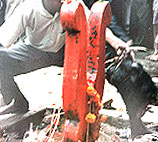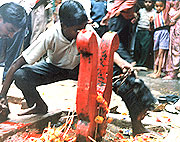 |
| a home away from home |
| HOME FEEDBACK TELL A FRIEND WEB SITE DESIGN CAREER WITH US CONTACT US |
 |
The age of Kali or Shaktism we do not have men who are desireless in their actions, who can subdue their minds and give up all works to become ascetics and who could remain chaste at heart even in the company of women. Hence with the passage of time the sacrifice became increasingly elaborate, and priests became highly skilled specialists. The meaning of the sacrifice also changed. As the socio-economic structure of the Hindu communities became increasingly complicated, so did the ritualistic practices and their implications. Sacrifice in the form of bloodshed became an integral |
part
of Hindu ritualistic practices.
In India bali or balidan or animal sacrifice is performed among different Hindu communities at various parts of the country. Bali or animal sacrifice is usually related to the worship of Shakti in Hinduism. In the practice of Shaktism goddesses like Kali, Durga are considered as embodiment of power, and so it is essential to incorporate bali or animal sacrifice in the worship. Various types of animals and other objects are sacrificed before these goddesses and certain gods and each of these has a symbolic implication in the practice.
|
For example in the vedic age one might find instances of Ashwamedh Yajna or Horse sacrifice and also Goumedha Yajna or Cow sacrifice. Horse sacrifice was one of the most important royal rituals of Vedic religion, described in detail in the Yajurveda. The Ashvamedha could only be conducted by a king. Its object was the acquisition of power and glory, the sovereignty over neighbouring provinces, and general prosperity of the kingdom.The horse to be sacrificed must be a stallion, more than 24, but less than 100 years old. Pusyamitra Sunga is said to have performed the Ashvamedha rite after he toppled Mauryan rule in 185 BC. In the Mahabharata, the sacrifice is performed by Yudhishtira and in Ramayana it was performed by Rama. |
|
Cow sacrifice was also common at one time but as time passed people started realizing the importances of these two animals in their socio-economic life. Hence in the later age these sacrifices were banned and cow is considered as a holy animal in Hinduism. Ajmedha or goat sacrifice continued to be sacrificed from ancient times till date. Goats are most commonly used and may have the connotations of being the scapegoat of all the sins of the family who are patrons of the worship. | 
|
|
Literally speaking goats, sheep and deer are considered as symbols
of kam or extreme greed, passion and lust. On the other hand a buffalo
is most probably considered as a symbol of anger. Ritual killing
of various kinds of birds like rooster, duck, pigeon are usually
common among tribal communities. They
prefer these animals as objects of sacrifice probably due to their
lower economic conditions. |
GREAT INDIANS || BENGALI SECTION || BENGALI MARRIAGE || BABY'S NAME || WALLPAPER || BENGAL || WEATHER || TRAVEL
MOBILE WALLPAPER || E-CARD || MOVIE || WEBSITE LINKS || ASSOCIATIONS || SHOPPING || ASTROLOGY || MUSIC || BEAUTY CARE
TIGER || NEWS || GUEST CORNER || FEEDBACK || LINK TO US || FOR ADVERTISING || SERVICES || CONTACT || BENGALI CALENDAR
Graphics, Sound or content copied or produced in part or whole in any media will be illegal.
Persons or websites caught using our material will be penalized.
Privacy Statement || Copyright
Copyright ©1999-2014 BANGALINET.COM